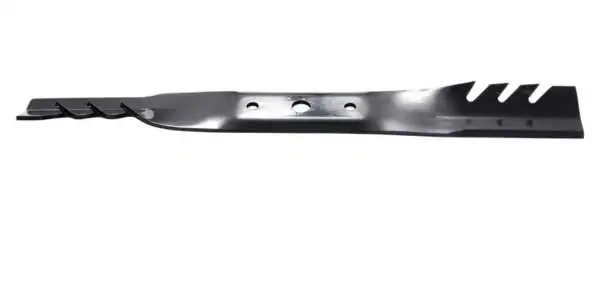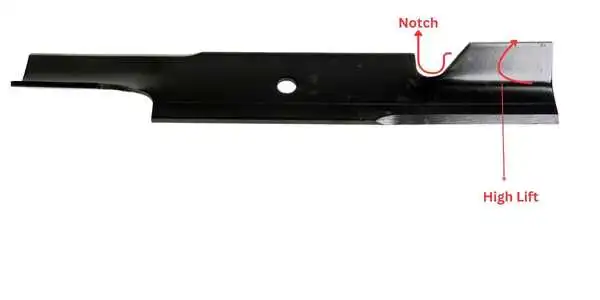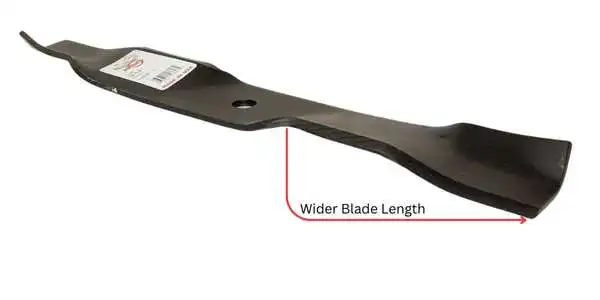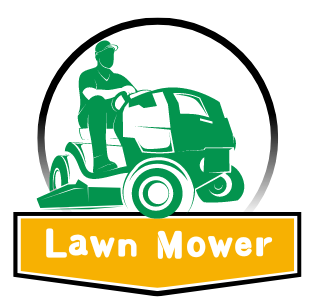Today, we’re talking about the different kinds of lawn mower blades. There are four main styles that work with any deck size. Knowing the difference between these blades is key when you’re buying one, especially depending on whether you want to bag the grass, spread it to the side, or mulch it. We’ll go over things like blade height, shape, and what each blade does.

Low Lift Blades: A Closer Look
Low lift mower blades are made for specific grass-cutting jobs where you don’t need much airflow. Unlike high lift blades that suck up grass clippings efficiently, low lift blades are angled differently to create less lift. This makes them great for areas with sandy or rocky soil, where you don’t want to pull up sand, hence minimizing sandblasting, and will eventually extend the lifespan of the mower deck.
These blades also save fuel because they don’t need as much power to work. They’re good for people with big lawns or who mow commercially because they can cut down on fuel costs over time.
Another perk of low lift blades is they help prevent grass clumps. Since they don’t create much airflow, grass clippings don’t stick together and clog up the mower deck. This leaves your lawn looking nicer after you’re done mowing.
But remember, low lift blades aren’t the best choice for every mowing job. If you need to bag clippings or mulch finely, other blades might be better. Still, for regular mowing in places with little debris and where saving fuel matters, low lift blades are a better choice.
If you’re keen on learning how to sharpen your current mower blade, be sure to give this article a read!

Medium Lift Blades (Gator Blades)
Firstly, it’s important to clarify the naming convention associated with these blades. Although, Oregon is the sole company that officially labels their tooth blades as “Gator blades,” the term “Gator blade” has become widespread in the industry to refer to tooth style blades. Oregon produces popular blade variants like the G5, G6, and G3.
However, it’s important to note that several other companies manufacture similar tooth style blades but they are not called Gator blades.
Gator blades are specifically designed to improve grass mulching without the need for a separate mulch kit. They achieve this through a tooth-style lift wing that directs grass clippings toward the center of the blade, ensuring consistent chopping as they move across the deck. This feature makes them particularly useful during leaf cleanups in fall and spring, as they efficiently mulch leaves without the hassle of bagging.
Among the different variants, G5 and G6 blades stand out with their wider, thicker build and high lift design, providing enhanced cutting efficiency and better grass dispersal. The extended cutting edge and carbide-infused edge of these blades ensure longevity and sharpness, making them suitable for year-round use.
However, it’s essential to consider the application when choosing a blade type. While high lift blades like G5 and G6 excel in cutting tough grass and weeds, they may not be ideal for sandy or dirty conditions due to increased debris intake, leading to premature wear.
When choosing a blade design or style, prioritize your preferences and needs. However, ensure that the thickness and size of the blade align with your lawn mower’s capacity. For instance, thicker blades may require more horsepower to operate effectively.

High Lift Blades: Power and Performance Combined
High-lift blades are like the heavy-duty vacuum cleaners of lawn mower blades. They’re shaped with curves or wings along the edges and a higher lift in the middle, which helps them suck up grass clippings effectively. These blades are great for big lawns and commercial mowers because they can handle thick grass easily. But keep in mind, that they need more power to work and might use more fuel than other blades.
While these blades are mainly for bagging, you can also use them for side discharge. Their strong airflow pushes clippings far from the mower, so you get a more even spread.
Although they’re not made specifically for mulching, you can still use high-lift blades for it. They might not chop the clippings as finely as mulching blades, though.
You can find high-lift blades for all kinds of lawnmowers, so they’re a good choice for different mower models.

Mulching Blade: The Eco-Friendly Solution
If sustainability is a priority in your lawn care routine, consider using a mulching blade. These blades are specifically designed to chop grass clippings into fine particles, which are then returned to the soil as natural fertilizer. By recycling grass clippings back into the lawn, mulching blades promote healthier, greener turf while reducing the need for chemical fertilizers.
Unlike high-lift blades, mulching blades have a lower lift, which helps keep the clippings suspended longer for thorough chopping. This finely chopped mulch decomposes in the soil faster.
Some mowers have special mulching kits that include blades, baffles, and deflectors to make mulching even better. Knowing all about mulching blades helps people make their lawns really healthy and green while also being kind to the environment.
Mulching blades are incredibly versatile, serving multiple purposes including mulching, bagging, and side discharging. While they excel at both mulching and side discharge functions, there’s a difference in the outcome. When used for side discharge, the mower expels clippings more rapidly, potentially leading to longer pieces compared to the finely chopped clippings produced during mulching.
Aftermarket vs. OEM Blades: Making an Informed Choice
People often talk about whether it’s better to use aftermarket or OEM blades. Aftermarket blades might save money, but OEM blades are usually liked more because they’re tested really well and made to fit specific mower models perfectly.
I wanted to share my recent experience with aftermarket Gator Blades for my Walker SD mower. Honestly, it’s been nothing short of a headache. From the moment I installed them, they started hitting each other intermittently, causing all sorts of issues. The supplier even suggested that my deck was somehow out of alignment, which just wasn’t the case.
Comparing them to the Walker high lift blades, the differences were clear. The Gator Blades were slightly longer and had straight ends instead of the tapered design of the Walkers. Despite being promised top-notch performance, they ended up being nothing but a waste of money, sitting idle in my garage.
So, I would highly recommend sticking with factory options. Trust me, you’ll save yourself a lot of hassle in the long run.
Conclusion
Choosing the right mower blade is crucial to maintaining a beautiful lawn. Have you ever wondered which type of blade would work best for your lawn? Whether you’re dealing with challenging soil conditions or seeking maximum power and performance, understanding the differences between blade types can make a big difference in your lawn care routine. With the right information and assistance, both homeowners and professionals can ensure their mower delivers flawless results every time. So, which mower blade do you think would suit your lawn best? comment below!
Check out more articles below
Self Propelled Vs Push Mower: The Best Ever Guide

